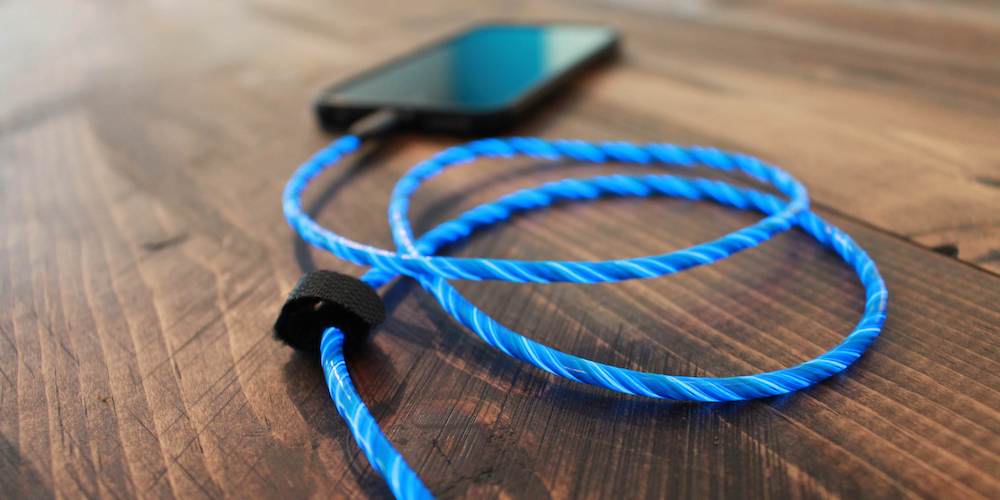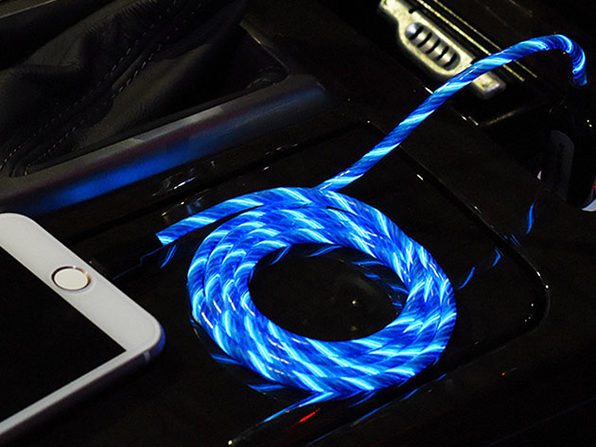Electron Flow MFi-Certified Lightning Cable Review
 Credit: Neva Tech
Credit: Neva Tech
Toggle Dark Mode
Charging cables are usually an afterthought when it comes to our charging needs — a necessity, but something that’s overlooked in favor of a flashier battery or maybe even newer technology, like a wireless charging pad (for all you owners of the latest and greatest iPhone model). That is, until the standard cord you have frays, tears or develops impossible to unravel kinks in it — and you have to shell out cash for what you know will (eventually) be just another disposable Lightning cable. Or how about when you buy a model that’s less expensive, only to find it doesn’t work with your iPhone. Even worse, finding out that after you’ve used something supposedly “compatible”, your phone starts displaying warning signs while acting erratically (a sign of potential damage).
Case in point, the thing you rely on at least once a day isn’t usually thought of — until it’s an inconvenience. In that instance, it’s usually because your Lightning cable or charging device isn’t MFi certified. What exactly is an MFi certification? Well, that has to do with Apple’s notoriously rigorous production and quality standards, and they don’t apply to just their iPhones, iPads, iPods and more. Those same intensive means for design and creation also include their Lightning cables, which include a proprietary connector that’s been around since 2012.
Inside each standard Apple Lightning connector is an authentication chip that communicates with your device, telling it that it’s Apple-certified (that’s where the MFi certification comes in). That’s important because if you use a connector that’s not MFi certified (essentially, a knock-off), it can actually damage your device, causing a warning message to be displayed on your iPhone. Because these non-certified cables weren’t made to work with your phone, they can get really hot as they try to function with non-compatible wiring. That can damage your iPhone terribly, overheating it to the point of causing permanent damage, or even causing your phone to stop working entirely. And after spending so much money on your phone, it’s a total waste to ruin it with a non-compatible cable.
Don’t worry — this doesn’t mean that you’re forced to use the standard charging cables that break and fray so easily with everyday use. These Electron Flow MFi-Certified Lightning Cables are not only MFi certified (UPC/EAN 6954900801639), but come in a whole variety of colors including blue, red and green in the standard length of 3-feet. But totally unlike the standard Lightning cable you’d typically use, the Electron Flow is wrapped in LED lights.
First Impressions
When you initially plug it into a USB port or connect it to a portable battery, it lights up and stops, until you connect it to your iPhone (or iPad, or iPod). Then the light flows like a ribbon up and down the length of the cord, in accordance with how quickly your phone is getting a charge — the light only stops flowing when your phone hits a full 100% charge.
The road to getting MFi certified is a tough one: it requires companies to have the necessary hardware components and to manufacture the product appropriately from inception.
Following that, there’s testing that needs to be done (and passed), technical information that needs updating, technical support to engage in when stuff goes wrong and a whole bunch of other phases before the final stage of product certification.
And in case you’re ever unsure about Electron Flow products being MFi certified, you can look up the company here — verified straight from the source (in this case, Apple).
This interactive response lighting system when charging your Apple device isn’t just funky and entertaining, it actually serves a whole multitude of purposes.
You know all those times you’ve accidentally knocked your phone off your table or nightstand, because it was dark as you were charging your phone overnight? That absolutely won’t happen with the Electron Flow MFi-Certified Lightning Cable. You really can’t miss it, no matter what color you have, especially when your device’s battery is filling up.
You can use it as a nightlight, a flashlight in a pinch and even as a reading light if you’re charging your phone on a plane, bus or train — and it’s way less obtrusive, and shines a better light on your reading material than the far-away light overhead.
Design
Despite how fun the cord looks, the Electron Flow MFi-Certified Lightning Cable endured rigorous testing to not only conform to MFi and USB standards (with a 2.4 amps of charging capacity), but to be built in a way that is far more durable than the stock cables you get. The cable heads on the USB and Lightning connectors are thicker and stronger than the standard ones you would find on the ones that come with your phone since they’re wrapped in see-through PVC in whatever color you choose to snag them in.
Plus, the Electron Flow cables have an anti-fray system in place at the ends of the cables where the heads meet, meaning you won’t get the same annoying kinks and breakage you usually deal with in standard cables. All those usually take is a hard toss around in your bag on the way to work, and they’re done for — making them essentially disposable. But these Electron Flow cables passed a 5,000 bend test, meaning they were manipulated and twisted every kind of way 5,000 times — without showing any wear and tear that diminished functionality.
Functionality
Beyond function and design, from a style standpoint, these cables are a fresh take on something that’s usually pretty boring and utilitarian. It’s actually really useful to see how quickly your device is charging by taking note of how quickly the light flows through the cord. A faster flow means a faster charge.
At one point during my time with this cable, I was concerned it wasn’t compatible with my iPhone, and that’s the reason the light stopped glowing — turns out, it was just because my phone was fully charged. That’s also super helpful for the antsy folks who are in a rush to give their phone a little extra juice before a full day on the road or in the office.
I was also worried that the light coming off the cord would be too harsh and keep me awake longer than necessary, but that’s not the case at all. The LEDs are certainly bright enough to illuminate a space and some pages on a book, but the glow isn’t anything like an actual lightbulb being on or close to your face. And the lights do stop once your phone or device is full, so if you are charging at night, that’ll ensure you’ll still receive a good night’s sleep.
As with anything else, the key to keeping your phone at 100% and your cable happy (i.e., extending its life), is treating it with some care. Here’s a few helpful tips:
- Whenever removing the cable from a power source, pull on the head of the cable (the hard plastic cover) not the cable itself. You’ll weaken the material of the cable if you do this often (most likely, at the same point in the cable over and over), causing breakage or fraying. Pulling from the plastic head will help ensure the longevity of the product, and maintain the integrity of the connection between the head and cable.
- When you need to store the cable, loosely loop the cable without kinking the cable. Sure, we’ve all been in a rush and thrown our charging cables into bags, backpacks, suitcases and purses — only to have them squished, kinked and broken over time. Instead of folding the cable, loop it — the spherical composition of the cord is definitely not meant to be folded, which creases the plastic shell and eventually causes the wiring inside to be exposed (and that could be dangerous).
- Keep your cord away from liquids. It may sound obvious, but work to keep your cord away from any liquids (water, soda, etc.) that can corrode the metal. In general, it’s best practice to keep your Lightning cable clean of any general dirt or grime, which can also wear it away before its time.
Final Thoughts
In short, there’s no reason not to want one (or a few) of these Electron Flow MFi-Certified Lightning Cables. They can help you find your phone in dark spaces and also add a little bit of fun to an everyday activity that’s usually pretty mundane. Plus, they’re a lot sturdier than standard Lightning cables. Keep one in your car for those unexpected times you need an extra cable, or toss it in your bag before you go travel — and certainly keep one by your nightstand for catching up on your reading list before bed, or just to add a little fun to an everyday task like charging your phone. These Electron Flow MFi-Certified Lightning Cables are available here for just $29.99.
Electron Flow MFi-Certified Lightning Cable
“It’s a fun, innovative, eye-catching take on a Lightning cable that doubles as a reading light. And it’s more durable than a standard charging cable.”










